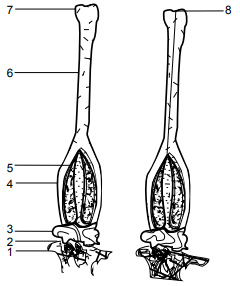The gynoecium consists of many free pistils in flowers of
(1) Papaver
(2) Michelia
(3) Aloe
(4) Tomato
The body of the ovule is fused within the funicle at :
| 1. | Micropyle | 2. | Nucellus |
| 3. | Chalaza | 4. | Hilum |
The plant parts which consist of two generations, one within the other, are:
| (a) | Pollen grains inside the anther |
| (b) | Germinated pollen grain with two male gametes |
| (c) | Seed inside the fruit |
| (d) | Embryo sac inside the ovule |
1. (a), (b) and (c)
2. (c) and (d)
3. (a) and (d)
4. (a) only
Shown below is a longitudinal section of the ovary, style, and stigma, showing the course followed by a pollen tube:

The parts marked as 4 and 5 are respectively:
1. Ovary and Ovule
2. Ovule and ovary
3. Style and stigma
4. Stigma and style
Which layer of the anther wall helps in its dehiscence?
| 1. | A | 2. | B |
| 3. | C | 4. | D |
The following diagram shows:
| 1. | Multicarpellary, syncarpus pistil of Papaver |
| 2. | Multicarpellary, apocarpus pistil of Papaver |
| 3. | Multicarpellary, apocarpous gynoecium of Michelia |
| 4. | Multicarpellary, syncarpous gynoecium of Michelia |
Identify the mismatch statement regarding post fertilization events from the following statements.
1.Wall of ovary is converted in to pericarp
2.Outer integument is converted in inner integument
3.Triploid nucleus develops as endosperm
4.Ovary is developed as fruit.
In some plants, the thalamus contributes to fruit formation. Such fruits are termed as:
1. False fruits
2. Aggregate fruits
3. True fruits
4. Parthenocarpic fruits
Which of the following is incorrect for wind-pollinated plants?
1. Well exposed stamens and stigma
2. Many ovules in each ovary
3. Flowers are small and not brightly colored
4. Pollen grains are light and non-sticky
Match Column I with Column II and select the correct option using the codes given below:
|
Column I |
|
Column II |
|
|
A. |
Pistils fused together |
1. |
Gametogenesis |
|
B. |
Formation of gametes |
2. |
Pistillate |
|
C. |
Hyphae of higher ascomycetes |
3. |
Syncarpous |
|
D. |
Unisexual female flower |
4. |
Dikaryotic |
Codes:
|
A |
B |
C |
D |
|
|
1. |
4 |
3 |
2 |
1 |
|
2. |
2 |
1 |
4 |
3 |
|
3. |
1 |
2 |
4 |
3 |
|
4. |
3 |
1 |
4 |
2 |
स्तंभ II के साथ स्तंभ I का मिलान करें और नीचे दिए गए संकेतों का उपयोग करके सही विकल्प चुनें:
|
स्तंभ I |
|
स्तंभ II |
|
|
A. |
स्त्रीकेसर एक साथ संगलित |
1. |
युग्मकजनन |
|
B. |
युग्मकों का गठन |
2. |
स्त्रीकेसरी |
|
C. |
उच्च एस्कोमाइसिटीज के कवक तंतु |
3. |
युक्तांडपी |
|
D. |
उभयलिंगी मादा पुष्प |
4. |
द्विकेंद्रकी |
Codes:
|
A |
B |
C |
D |
|
|
(1) |
4 |
3 |
2 |
1 |
|
(2) |
2 |
1 |
4 |
3 |
|
(3) |
1 |
2 |
4 |
3 |
|
(4) |
3 |
1 |
4 |
2 |








